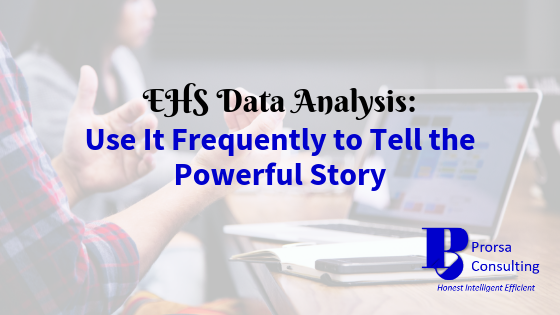EHS Data Analysis: Use It Frequently to Tell the Powerful Story
By : Admin -

Environmental, health, and safety (EHS) data and EHS information are not the same. Data encompasses the facts and figures we collect. Information tells the story and provides the meaning behind facts and figures. EHS data analysis serves as the bridge between the two.
We all know information makes the world go around. It endows decision-makers with the necessary background to enact sound, EHS performance-enhancing decisions.
All EHS-regulated entities must collect data to meet compliance obligations, but are you advantageously using the data to relay your EHS program’s story to business leaders?
Read on for some simple EHS data analytics you can use to help bolster the information used to tell your EHS narrative.
Disclaimer: This blog post may contain affiliate links and any purchases made through such links will result in a small commission for Prorsa Consulting (at no extra charge to you). Feel free to visit our Disclosure of Material Connection for more information.
EHS Data Analysis: Data Preparation Basics
Data Collection
Useful EHS data analysis begins with robust data collection.
This collection can be a manual process, such as mining incident reports to collect data points and performing entry into a spreadsheet.
Alternatively, data collection may take place automatically.
We can see this in such applications such as continuous emission monitoring systems where data gets procured and transferred into a database without human intervention.
In either case, broader data collection efforts generally enhance the resulting information. So, err on the side of capturing as much information as necessary for healthy data evaluation.
This will help to support your planned, ongoing EHS data analytics and hopefully provide data for future analyses you may not currently have on the agenda.
Data Processing
Processing data improves the likelihood for strong results. It ensures you start with a complete, accurate dataset.
Moreover, data processing assists to confirm you have the right data to answer the questions you seek to solve through your analysis efforts.
As an added bonus, this step works to make your analytical results reproducible should a duplicate EHS data analysis be needed at some later date.
At a minimum, data processing should include the following:
- A data review for entry errors or erroneously reported data. You should correct these as you identify them.
- Transformation of all data into appropriate units. For example, if pollutant concentration data were collected in percent weight but you need your data points to reflect concentrations in parts per million (ppm), the processing stage would provide the best time to convert the data.
- Identification, collection, and entry of any omitted data points. For instance, if the dataset needs to provide an analysis of a specific data point across time or for multiple facilities, you will want to ensure you have all data points for the timeframe or group of facilities subject to the assessment.
Data collection and processing have an ongoing presence in the world of EHS data analysis.
As such, they should be integrated into existing processes within an EHS program for maximum effectiveness.
EHS Data Analysis: The Art of Descriptive Statistics
Descriptive statistics depict certain aspects of a dataset.
For example, if I surveyed 500 EHS managers, one of the descriptive statistics for the set could be the percentage of managers with a professional certification in EHS.
Descriptive statistics get utilized far more than other methods for EHS data analysis.
Moreover, they possess immense value due to the high degree of flexibility they bring to EHS analytics.
You can glean information about almost any aspect of a dataset through descriptive statistics.
Furthermore, descriptive statistical methods can apply to a complete set or subsets of data quite easily.
Finally, special tools and resources are generally not needed for descriptive statistical EHS data analytics.
You can easily accomplish a solid assessment of small to moderately sized datasets through the use of the descriptive statistical formulas in Microsoft® Excel.
What descriptive statistics work well with EHS data?
- Traditional rates of occurrence (incidents, injuries, illnesses, emission rates)
- Frequencies (i.e. the number of times an event occurs within a given timeframe, such as 5 back injuries in a month or 2 emission exceedances in 24 hours)
- Percentages showing parts of a whole or giving a delta (Δ) for a given statistic (for instance, lost time injuries at 10% of total injuries for the month or greenhouse gas emissions decreased by 22% from last year)
- Averages (years of experience of injured workers, emissions or other pollutant discharges, return to work timeframes, etc.)
EHS Data Analysis: Predictive Statistics
While descriptive statistics provide insight into past occurrences, predictive statistics help to highlight what may happen in the future.
This proves helpful when looking to prepare for future conditions and identifying potential opportunities for improvement.
The potential of predictive statistics makes it an exciting pursuit for most organizations.
However, businesses should use caution when making predictions.
There is no 100% proven, predictive statistical model. If there were, everyone would win every day in the lottery or stock market.
Therefore, the organization should pay close attention to the measures of fit for a dataset when utilizing models for predictive purposes.
What predictive statistics should be considered for EHS data analysis?
With the advent of big data, machine learning, and artificial intelligence, in-depth predictive analytics is most often completed through complex software programs.
Yet, you can still avail yourself of respectable predictive models for EHS data analysis with spreadsheets and the following:
- Linear regression (plotting two dependent variables in a dataset and determining the best fit line for prediction, such as estimated fuel use to predict carbon emissions or estimated number of citations to predict expected penalties)
- Moving Averages (subsequent averages from constant-sized and overlapping groupings, usually of time; for instance, predicting monthly incident rates for the remainder of the year by successively averaging the previous 3 months’ known or predicted incident rates; this method will smooth data variability)
So, are you ready to dive in? If so, you may benefit from more in-depth information on statistics to support your EHS data analysis program. The following book should help support your initial efforts.
EHS Data Analysis: Secrets for Effective Communication
So, now you have all this EHS information from your EHS analytics. How do you convey it?
Begin by focusing your communication efforts on the most pertinent EHS information.
Determine the story you want to tell and emphasize the EHS data analytics supporting the story.
For example, if you want to showcase a decrease in slips, trips, and falls in stairways after retreading stairs, you do not need to include the falls that occurred outside of stairways.
Additionally, make sure prepared reports and summaries strengthen your narrative.
Mix written data insights with graphs and charts to reinforce your findings.
Keep reports and summaries concise, and make these readily available (preferably on demand) for those regularly utilizing EHS information.
Moreover, you should relay your EHS data analysis results in more than one format because all people do not receive and process information in the same manner. So, try a combination of formats like:
- Information on the internet and intranet portals
- Written reports within your organization’s knowledge management system
- Oral summaries at toolbox talks
- Presentations at EHS committee meetings
Remember to make your communications frequent.
Adults have to process information several times before they retain it or act on it. This holds true for EHS information, as well.
With more frequent communications of the same EHS analytics, people will gain an understanding over a shorter time period and be able to react sooner.
Finally, be sure to invite questions and discussion on EHS data analysis findings.
This hopefully will lead you to the discovery of potential improvement opportunities.
Moreover, individuals not involved in the analysis may uncover the need for other EHS data analyses or identify possible data issues of which you were unaware.
Concluding Thoughts
Recording meaningful EHS data marks only the beginning of the journey.
The processing and analysis of EHS data points reveal the true story of what is occurring or may occur within your operations.
Furthermore, effective communication of EHS data analysis results conveys that story to those who need to hear it.
Through these actions, EHS data analytics can form a solid foundation of knowledge, supporting sound decisions to positively impact EHS performance.
We encourage your feedback on this blog’s content. Be sure to like and/or share below. You can also provide us with feedback via our Contact Us page.
Also, don’t forget to follow Prorsa Consulting on LinkedIn, Pinterest, and Twitter.
Email contact@prorsaconsulting.com with questions on our services.
How would you like to get additional, exclusive EHS updates and info from Prorsa Consulting? All you have to do is subscribe to the Prorsa Consulting Newsletter below. You’ll gain access to our Free Resources area and all the tools, templates, and presentations in the library. Get your free subscription today!





